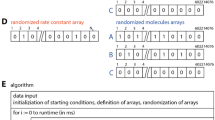Abstract
This article shows how to evaluate rotational symmetry numbers for different molecular configurations and how to apply them to transition state theory. In general, the symmetry number is given by the ratio of the reactant and transition state rotational symmetry numbers. However, special care is advised in the evaluation of symmetry numbers in the following situations: (i) if the reaction is symmetric, (ii) if reactants and/or transition states are chiral, (iii) if the reaction has multiple conformers for reactants and/or transition states and, (iv) if there is an internal rotation of part of the molecular system. All these four situations are treated systematically and analyzed in detail in the present article. We also include a large number of examples to clarify some complicated situations, and in the last section we discuss an example involving an achiral diasteroisomer.
Article PDF
Similar content being viewed by others
Explore related subjects
Discover the latest articles and news from researchers in related subjects, suggested using machine learning.Avoid common mistakes on your manuscript.
References
Eyring H (1935). J Chem Phys 3: 107–115
Evans MG and Polanyi M (1935). Trans Faraday Soc 31: 875–894
Truhlar GG, Isaacson AD, Garrett BC (1985) Theory of chemical reaction dynamics. In: Baer M (ed) CRC Press, Boca Raton, vol 4, pp 65–137
Truhlar DG, Garrett BC and Klippenstein SJ (1996). J Phys Chem 100: 12771–12800
Fernández-Ramos A, Ellingson BA, Garrett BC and Truhlar DG (2007). Rev Comp Chem 23: 125–232
Garrett BC, Truhlar DG (1998) Encyclopedia of computational chemistry. In: Schleyer PvR, Allinger NL, Clark T, Gasteiger J, Kollman PA, Schaefer III HF (eds) Wiley, Chichester, vol. 5, pp. 3094–3104
Pollak E and Pechukas PJ (1978). J Am Chem Soc 100: 2984–2991
Coulson DR (1978). J Am Chem Soc 100: 2992–2996
Herzberg G (1950) Molecular spectra and molecular structure: spectra of diatomic molecules, 2nd edn, Van Nostrand D (ed) Princeton, NJ, pp. 132–139
McQuarrie DA (2000). Statistical mechanics. University Science Books, Sausalito
Wilson EB (1935). J Chem Phys 3: 276–85
Bunker P, Jensen P (1998) Molecular symmetry and spectroscopy. Edited by NRC Research press, 2nd edn
Chakraborty A, Truhlar DG, Bowman JM and Carter S (2004). J Chem Phys 121: 2071–2084
Truhlar DG (1976). J Chem Phys 65: 1008–1010
Dennison DM (1927). Proc Roy Soc Lond Ser A 115: 483–486
Schatz GC and Kuppermann A (1976). J Chem Phys 65: 4668–4692
Truhlar DG and Abdallah J (1974). Phys Rev A 9: 297–300
Hu W-P, Rossi I, Corchado JC and Truhlar DG (1997). J Phys Chem A 101: 6911–6921
Truhlar DG (1991). J Comput Chem 12: 266–270
Chuang YY, Radhakrishnan ML, Fast PL, Cramer CJ and Truhlar DG (1999). J Phys Chem A 103: 4893–4909
Chuang YY, Truhlar DG (2000) J Chem Phys 112: 1221–1228; (2004) 121: 7036(E); (2006) 124: 179903(E)
Ellingson BA, Lynch VA, Mielke SL and Truhlar DG (2006). J Chem Phys 125: 84305–84317
http://www.en.wikipedia.org/wiki/Tartaric_acid
http://www.en.wikipedia.org/wiki/Diastereomer
Author information
Authors and Affiliations
Corresponding authors
Rights and permissions
Open Access This is an open access article distributed under the terms of the Creative Commons Attribution Noncommercial License ( https://creativecommons.org/licenses/by-nc/2.0 ), which permits any noncommercial use, distribution, and reproduction in any medium, provided the original author(s) and source are credited.
About this article
Cite this article
Fernández-Ramos, A., Ellingson, B.A., Meana-Pañeda, R. et al. Symmetry numbers and chemical reaction rates. Theor Chem Account 118, 813–826 (2007). https://doi.org/10.1007/s00214-007-0328-0
Received:
Accepted:
Published:
Issue Date:
DOI: https://doi.org/10.1007/s00214-007-0328-0
Keywords
Profiles
- Donald G. Truhlar View author profile




